This article was co-authored by Claudia Carberry, RD, MS. Claudia Carberry is a Registered Dietitian specializing in kidney transplants and counseling patients for weight loss at the University of Arkansas for Medical Sciences. She is a member of the Arkansas Academy of Nutrition and Dietetics. Claudia received her MS in Nutrition from the University of Tennessee Knoxville in 2010.
There are 16 references cited in this article, which can be found at the bottom of the page.
wikiHow marks an article as reader-approved once it receives enough positive feedback. In this case, 81% of readers who voted found the article helpful, earning it our reader-approved status.
This article has been viewed 601,226 times.
Counting calories is a useful strategy for losing weight. Since all packaged foods in the US must contain a nutrition facts label, this should be pretty easy to do. If you need to know the exact number of calories coming from fat, protein, and carbs, then you will have to do a little extra math. In cases where your food doesn't have a label, like at a restaurant, try looking up dishes or ingredients using an online food composition database or calorie calculator. After reading this article, you might want to calculate your total daily calorie needs.
Steps
Help Calculating and Counting Calories
Adding up Calories by Nutrient
-
1Locate the nutrition facts on the item’s packaging. In many parts of the world, food manufacturers are required by law to provide nutritional information on packaged food products. This information is presented in the form of a chart, which can usually be found on the back or side of the package. If you’re curious about what you’re eating, the nutrition facts label is where you should look first.[1]
- A food’s nutrition facts can tell you everything you need to know about what’s in it, including a comprehensive ingredients list and an overview of each of the major macronutrients.
-
2Note the amount of protein, carbohydrates, and fat contained in the item. When assessing a food’s nutritional value, you should look at 3 things: protein, carbs, and fat. These macronutrients account for all of the calories in the item (aside from calories from alcohol). As a result, the exact amount of each macronutrient indicates what proportion of the total calories they make up.[2]
- Alcohol also contains a significant number of calories. Each gram of alcohol is about 7 calories.
Advertisement -
3Multiply each macronutrient by its caloric equivalent. A gram of protein is estimated to contain about 4 calories. A gram of carbohydrates also has 4, and a gram of fat is worth a whopping 9 calories. If the item you’re eating contains 20g of protein, 35g of carbs, and 15g of fat, this means you would multiply 20x4, 35x4, and 15x9 to find the number of calories contributed by each macronutrient—80, 140, and 135, respectively.[3]
- Nutrients are always measured in grams. Make sure you’re using the right standard when calculating food calories yourself.
-
4Total the calories for each macronutrient. Now that you know how the calories are divided up, add together each individual count to get the combined calorie count for one serving of the item. Going off the previous example, 80 + 140 + 135 = 355 calories. This number should correspond with the estimate displayed on the item’s packaging.
- Breaking down the calorie count by macronutrient rather than simply reading it off the box allows you to see not just how many calories are in a certain type of food, but how to make them part of a balanced diet.
- 355 calories might not sound like a lot, but if you’re trying to eat less fat, you might be alarmed to discover that fat grams account for nearly half of the total.
-
5Take serving size into account. Be aware that the figures for both the calories and macronutrients represented in the nutritional facts only indicate a single recommended serving. If there are multiple servings included in the package, the total number of calories will actually be much higher.[4] This can be an important fact to keep in mind if you’re tracking calories as part of a diet or exercise plan.[5]
- For example, an item containing 355 calories per serving and with 3 servings per package makes the total 1,065 calories.
-
6Compare the calories of different nutrients to their recommended daily values. According to dietitians and other food experts, 46-65% of the total calories you consume on a daily basis should come from carbohydrates, 10-35% from protein, and 20-25% from fats. The recommended daily value (DV) column featured in the nutrition facts will tell you how much of those proportions you’re getting from the item.[6]
Using a Calorie Calculator or Guidebook
-
1Use an online calorie calculator to look up nutritional information quickly. If you have a computer or smartphone, you have many useful calorie-counting tools at your fingertips. Resources like the USDA’s Food Composition Database[9] or WebMD’s Food Calorie Calculator[10] archive the nutrition facts for virtually every food imaginable and make them easy to view with the touch of a button.[11]
- Non-packaged items, like fresh fruits and vegetables and prepared meals in restaurants, don’t give you the benefit of being able to review the relevant nutrition facts. An online calorie counter can come in handy when you want to know more about what’s in these foods.
- Some calorie counters only offer the number of calories and recommended serving sizes of the foods you look up. Others may also give you their macronutrient values.[12]
-
2Carry a food composition guidebook when you’re on the go. As an alternative to online tools, there are also traditional publications that document the nutritional value of common food items. Bring your guidebook with you when you eat out or go grocery shopping to get a sense of how various foods are being used in your body.[13]
- A few of the most popular food composition guides include “The Complete Book of Food Counts” by Corinne T. Netzer, “Nutritive Value of Foods,” by Susan E. Gebhardt, and the USDA’s “Handbook of the Nutritional Value of Foods in Common Units.”[14]
- Some guidebooks even report the nutritional value of menu selections at well-known restaurants. If you’re ever wanted to know how many calories are in a Bloomin’ Onion from Outback Steakhouse, now’s your chance!
-
3Search for a food or ingredient. Type in the name of the item or flip through your food composition guidebook until you find the correct listing. There, you’ll see the calorie count for the USDA recommended serving size, along with other info like the values of the major macronutrients and recommended daily values (DV).[15]
- Be sure to specify the exact serving size of the item you’re researching. Serving sizes are most often measured in cups, ounces, or grams.[16]
- The items in a food composition guide may be listed alphabetically or grouped into sections by category (such as fruits, vegetables, meats, bread products, or snack foods).
-
4Look up ingredients for homemade meals separately. If you’re curious about how many calories are in an entire meal, it will be necessary to record each ingredient individually. You’ll then add together the values according to the specific amount used in the dish. Grab a pen and piece of paper so you can write down each value as you go along—this will make it much easier to total them later.[17]
- To find out approximately how many calories are in a bowl of homemade beef stew, for example, you would need to refer to the listings for beef, potatoes, carrots, onions, and broth or stock, then figure out the number of calories found in the amounts that the recipe calls for.
- Don’t forget to include ingredients like butter, oil, shortening, and bread crumbs. These are often left out of calculations because they’re not thought of as main components of the dish.
-
5Consider the nutritional distinctions between similar foods. Scan the listings carefully and highlight the one that most closely matches the item you’re curious about. A chicken breast cooked with the skin on, for example, will be higher in fat and calories than a skinless one. Looking at the wrong item could give you an inaccurate impression of how healthy your food choices are.[18]
- Foods like fruits, vegetables, meats, nuts, and cheeses in particular come in a wide array. There are over 200 common varieties of potatoes sold in the US alone!
- Variety is common even among packaged food items. In some cases there may be 3-4 different kinds of the same product, including low-fat, high-protein, and whole grain variations.[19]
Warnings
- Nutrition facts, even the ones calculated by the USDA, can only offer rough estimates. There’s no way to know for sure exactly how many calories are in a given food. By law the figures only have to be accurate to +/- 20%.⧼thumbs_response⧽
References
- ↑ https://www.fda.gov/food/new-nutrition-facts-label/using-nutrition-facts-label-older-adults
- ↑ https://www.eatright.org/food/nutrition/nutrition-facts-and-food-labels/the-basics-of-the-nutrition-facts-label
- ↑ https://courses.lumenlearning.com/cheminter/chapter/energy-in-food-and-nutrition/
- ↑ https://www.eatright.org/food/nutrition/nutrition-facts-and-food-labels/the-basics-of-the-nutrition-facts-label
- ↑ https://www.nhs.uk/live-well/healthy-weight/understanding-calories/
- ↑ http://www.eatright.org/resource/food/nutrition/nutrition-facts-and-food-labels/the-basics-of-the-nutrition-facts-panel
- ↑ https://www.cdc.gov/diabetes/managing/eat-well/diabetes-and-carbohydrates.html
- ↑ https://www.fda.gov/food/new-nutrition-facts-label/how-understand-and-use-nutrition-facts-label
- ↑ https://fdc.nal.usda.gov/
- ↑ https://www.webmd.com/diet/healthtool-food-calorie-counter
- ↑ https://hnrca.tufts.edu/resources/nutrition-resources/calculating-calories-and-nutrients-meals
- ↑ https://www.sclhealth.org/blog/2018/10/what-are-macros-and-why-should-i-be-counting-them/
- ↑ https://www.foodstandards.gov.au/science/monitoringnutrients/afcd/Pages/default.aspx
- ↑ https://www.ars.usda.gov/is/np/NutritiveValueofFoods/NutritiveValueofFoods.pdf
- ↑ https://fdc.nal.usda.gov/
- ↑ http://hnrca.tufts.edu/flipbook/resources/restaurant-meal-calculator/
- ↑ http://hnrca.tufts.edu/flipbook/resources/restaurant-meal-calculator/
- ↑ http://hnrca.tufts.edu/flipbook/resources/restaurant-meal-calculator/
- ↑ https://www.consumerreports.org/cro/magazine/2014/03/too-many-product-choices-in-supermarkets/index.htm
- ↑ https://familydoctor.org/nutrition-keeping-a-food-diary/
About This Article
To calculate food calories, start by looking at how much protein, carbohydrates, and fat the food has. Then, multiply the total number of grams of protein by 4, since 1 gram of protein is equal to 4 calories. Do the same thing for the carbohydrates, since 1 gram of carbohydrates is equal to 4 calories. Next, multiply the total number of grams of fat by 9, since 1 gram of fat is equal to 9 calories. Finally, add up all 3 numbers to get the calorie count for 1 serving. To learn more from our Dietitian co-author, such as how to use a food calculator online to count calories, keep reading!



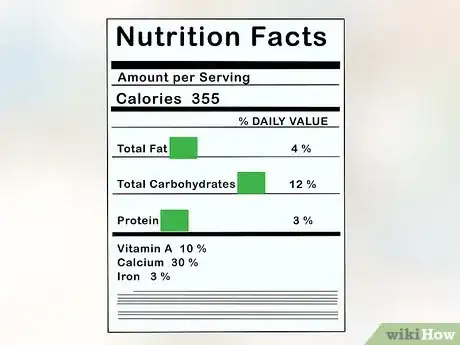
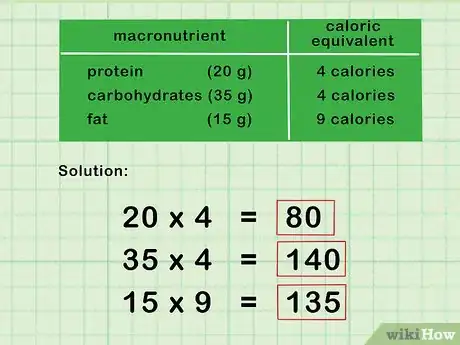
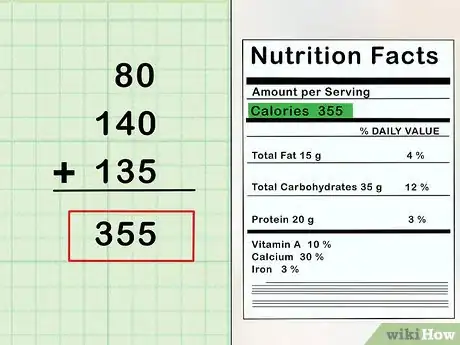

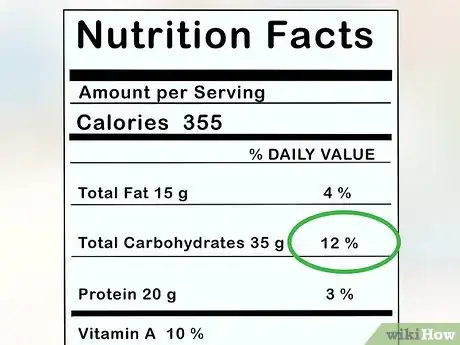



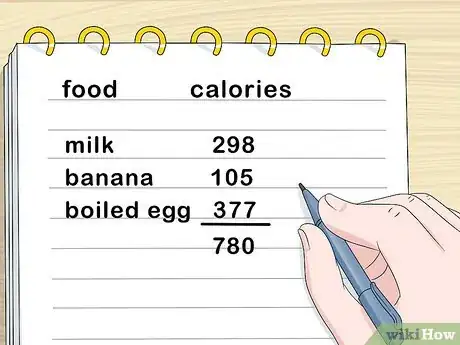
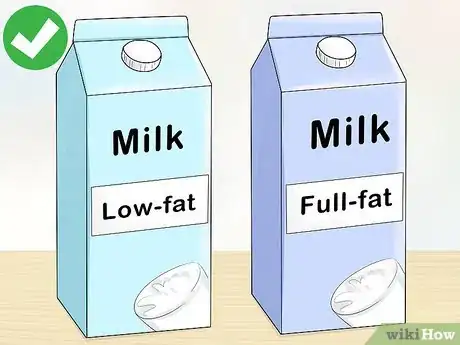
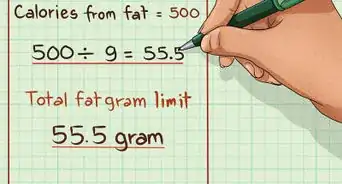




















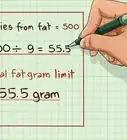






































Medical Disclaimer
The content of this article is not intended to be a substitute for professional medical advice, examination, diagnosis, or treatment. You should always contact your doctor or other qualified healthcare professional before starting, changing, or stopping any kind of health treatment.
Read More...